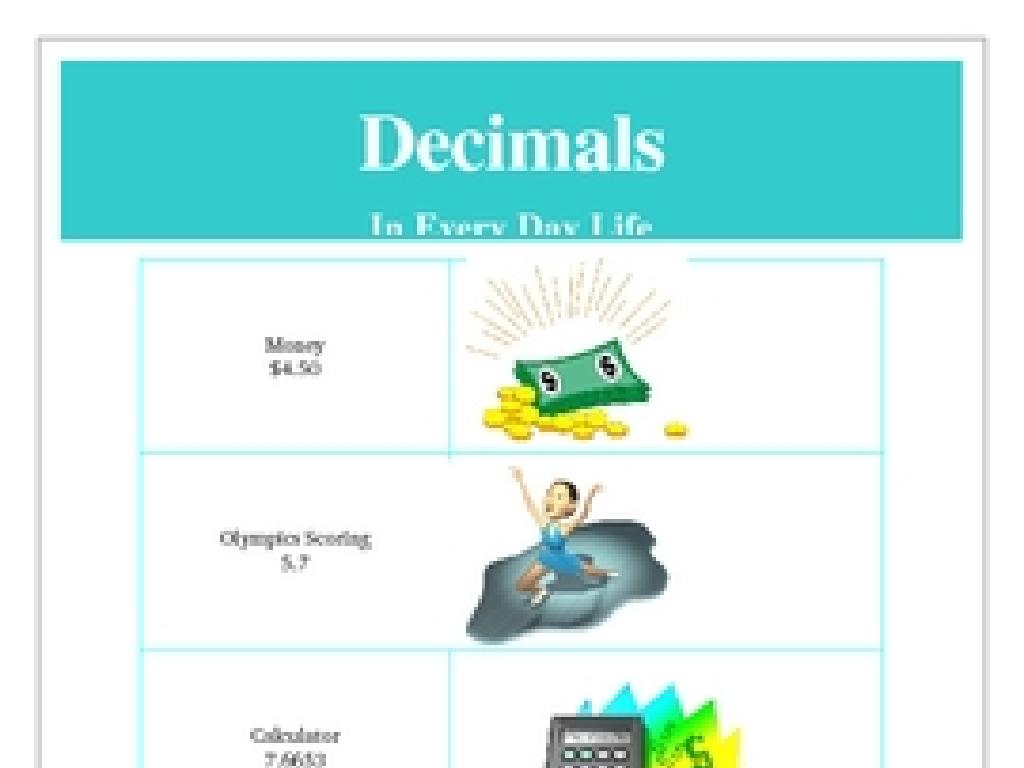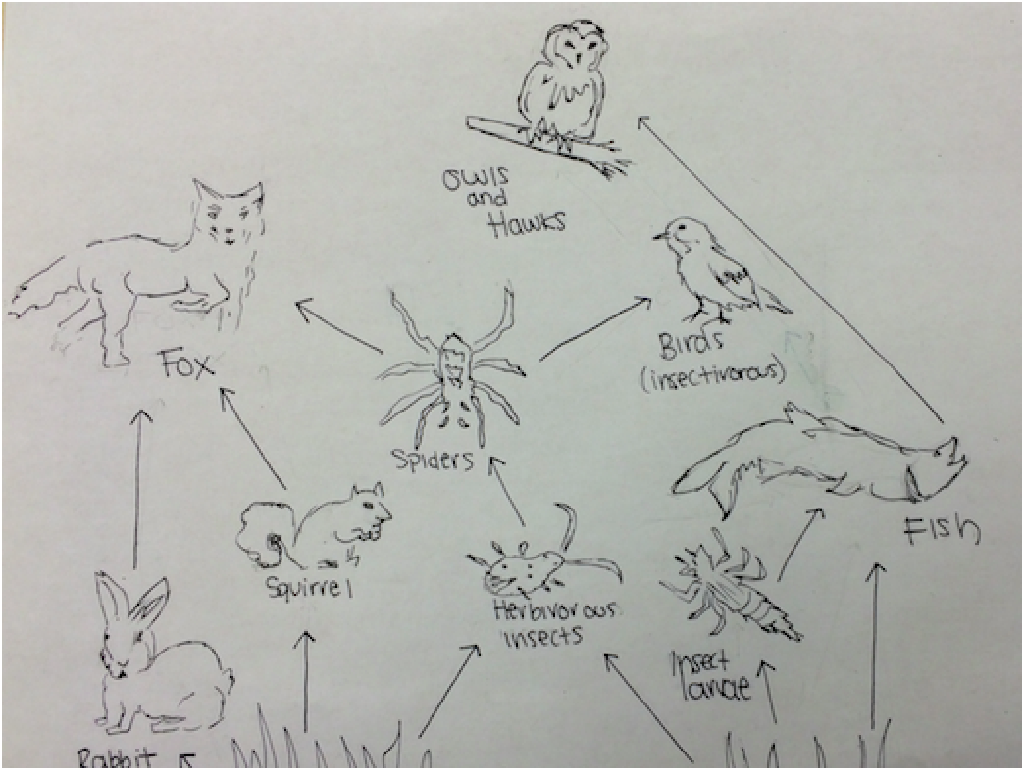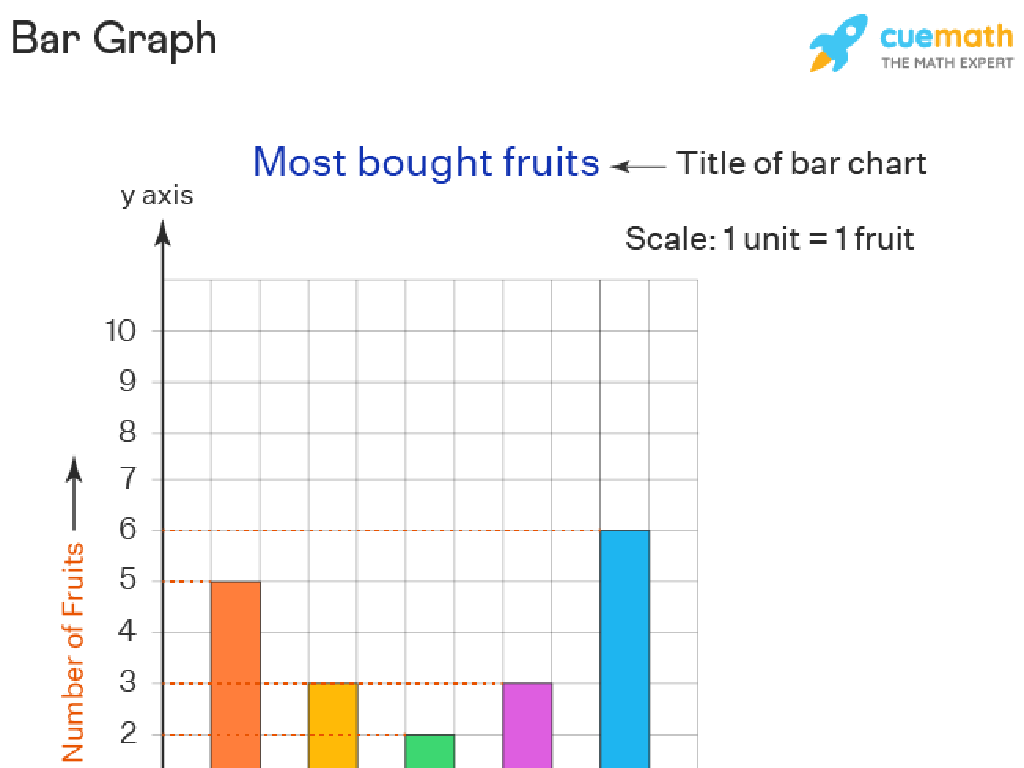Divide Fractions
Subject: Math
Grade: Sixth grade
Topic: Divide Fractions
Please LOG IN to download the presentation. Access is available to registered users only.
View More Content
Introduction to Dividing Fractions
– Recap: What are fractions?
– Fractions represent parts of a whole.
– Understanding division
– Division is sharing or grouping equally.
– Significance of dividing fractions
– It’s crucial for advanced math concepts.
– Practical applications
|
Begin the lesson with a quick review of fractions, ensuring students recall that fractions represent parts of a whole and consist of a numerator and denominator. Then, explain division as the process of splitting a quantity into equal parts or groups. Emphasize the importance of learning to divide fractions as it is a foundational skill that will be used in more complex math topics, such as algebra. Highlight real-world applications, such as dividing a pizza among friends or measuring ingredients for a recipe, to illustrate the practical use of dividing fractions. Encourage students to think of other everyday situations where they might need to divide fractions.
Visualizing Fraction Division with Pie Charts
– Understanding division via pie charts
– Pie charts show parts of a whole, helping visualize division.
– Dividing fractions by whole numbers
– To divide a fraction by a whole, multiply by its reciprocal.
– Example: 1/2 ÷ 2
– 1/2 ÷ 2 becomes 1/2 x 1/2. What’s the result?
|
This slide aims to help students visualize the concept of dividing fractions using pie charts. By representing fractions as parts of a pie, students can see how division splits these parts into smaller sections. When dividing a fraction by a whole number, we multiply by the reciprocal of the whole number. For example, dividing 1/2 by 2 is the same as multiplying 1/2 by 1/2, which results in 1/4. This visual and practical approach simplifies the abstract concept of fraction division, making it more accessible for sixth-grade students. Encourage students to draw their own pie charts for the example and other practice problems.
Dividing Fractions: Invert and Multiply
– Understand inverting a fraction
– To invert a fraction, flip the numerator and denominator. For example, the inverse of 2/3 is 3/2.
– Learn to multiply by the inverse
– After inverting, multiply the first fraction by this inverse.
– Example: Divide 3/4 by 2/3
– 3/4 ÷ 2/3 becomes 3/4 x 3/2. Multiply across to get 9/8.
|
This slide introduces the concept of dividing fractions by inverting and multiplying. Start by explaining that to divide by a fraction, you multiply by its inverse. Show students how to find the inverse of a fraction by flipping its numerator and denominator. Then, demonstrate the process using an example: dividing 3/4 by 2/3. Walk through each step, from inverting the second fraction to multiplying the numerators and denominators. Emphasize that this method works for any fractions and encourage students to practice with different examples to gain confidence.
Dividing Fractions by Fractions
– Apply the Invert and Multiply rule
– To divide, flip the second fraction and multiply
– Follow the steps to divide fractions
– Step 1: Invert the divisor, Step 2: Multiply the numerators, Step 3: Multiply the denominators
– Example: Divide 5/8 by 1/4
– 5/8 ÷ 1/4 becomes 5/8 * 4/1 = 20/8, which simplifies to 5/2 or 2 1/2
|
When teaching students to divide fractions by fractions, start by explaining the ‘Invert and Multiply’ rule, which is the key concept for division of fractions. Demonstrate the process step by step: first, invert the second fraction (the divisor), then multiply the numerators and denominators respectively. Use the example of dividing 5/8 by 1/4 to show this process in action. Simplify the result to show the final answer. Encourage students to practice this method with different fractions to gain confidence and understanding.
Let’s Practice Dividing Fractions!
– Divide 2/5 by 3/10
– Flip the second fraction and multiply: (2/5) ÷ (3/10) = (2/5) * (10/3)
– Divide 7/8 by 1/2
– Flip the second fraction and multiply: (7/8) ÷ (1/2) = (7/8) * (2/1)
|
This slide is dedicated to practicing the division of fractions with the class. Start by solving Problem 1 together, demonstrating how to flip the divisor (3/10 to 10/3) and change the division into multiplication. Work through the problem step by step, ensuring to simplify the result. Repeat the process with Problem 2, emphasizing the importance of flipping the second fraction and multiplying. Encourage students to participate in solving the problems and to ask questions if they’re unsure. After explaining, provide additional similar problems for students to try independently or in small groups to reinforce the concept.
Class Activity: Fraction Division Relay
– Form teams for the relay
– Each member solves a step
– Work together to finish
– First team with correct answer wins!
|
This activity is designed to encourage teamwork and understanding of fraction division. Divide the class into small groups, and give each team a set of fraction division problems. Each team member will be responsible for solving a part of the problem or a step in the division process. They will then pass the problem to the next team member to solve the next step, like a relay race. The first team to complete all problems correctly wins a small prize. This will help students to engage with each step of the process and rely on each other for accuracy. Possible steps include: rewriting the problem, finding the reciprocal of the divisor, multiplying the numerators, and simplifying the result. Make sure to walk around and monitor the groups, ensuring that each student participates and understands each step.
Conclusion: Mastering Fraction Division
– Recap key division concepts
Remember to invert and multiply to divide fractions.
– Understand the importance
Fraction division is essential for advanced math topics.
– Homework: Practice worksheet
Complete the worksheet to reinforce today’s lesson.
– Keep practicing for mastery
|
As we wrap up today’s lesson on dividing fractions, it’s crucial for students to remember the key steps: inverting the divisor and multiplying. Emphasize the importance of these skills as they are foundational for future mathematical concepts, including algebra. Assign a practice worksheet for homework to ensure students apply what they’ve learned. Encourage them to continue practicing, as mastery comes with repetition. The worksheet should cover a variety of problems, including word problems, to help students see practical applications of fraction division.






